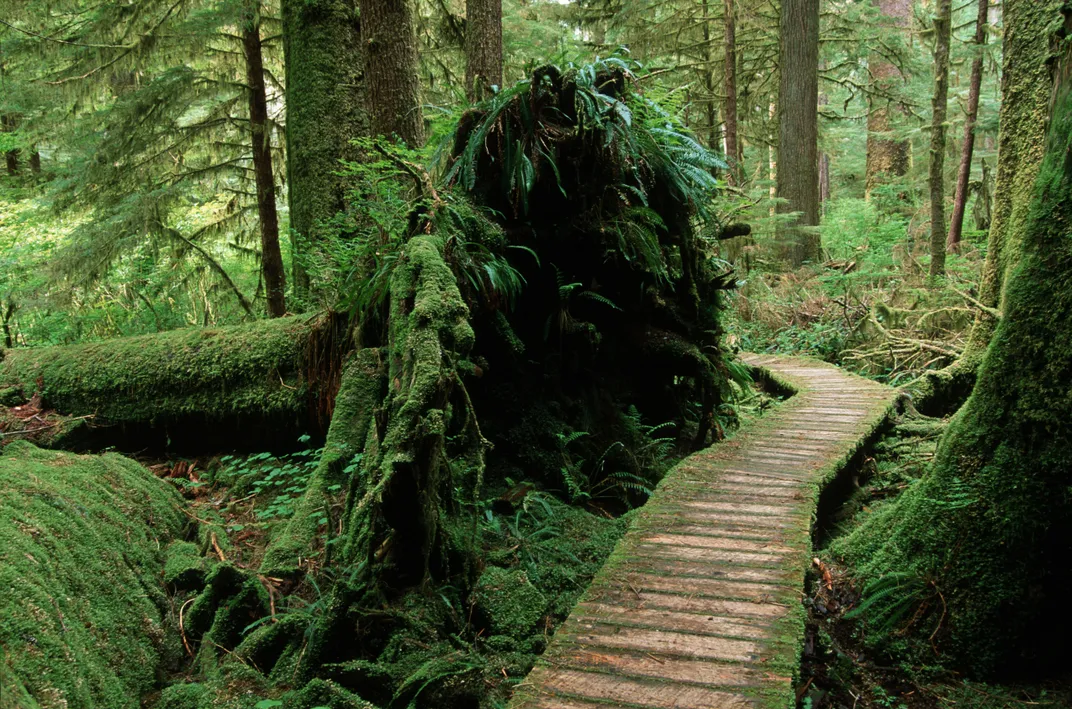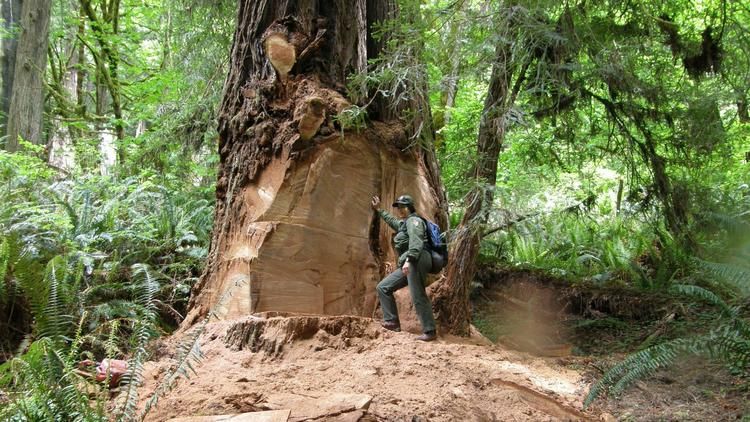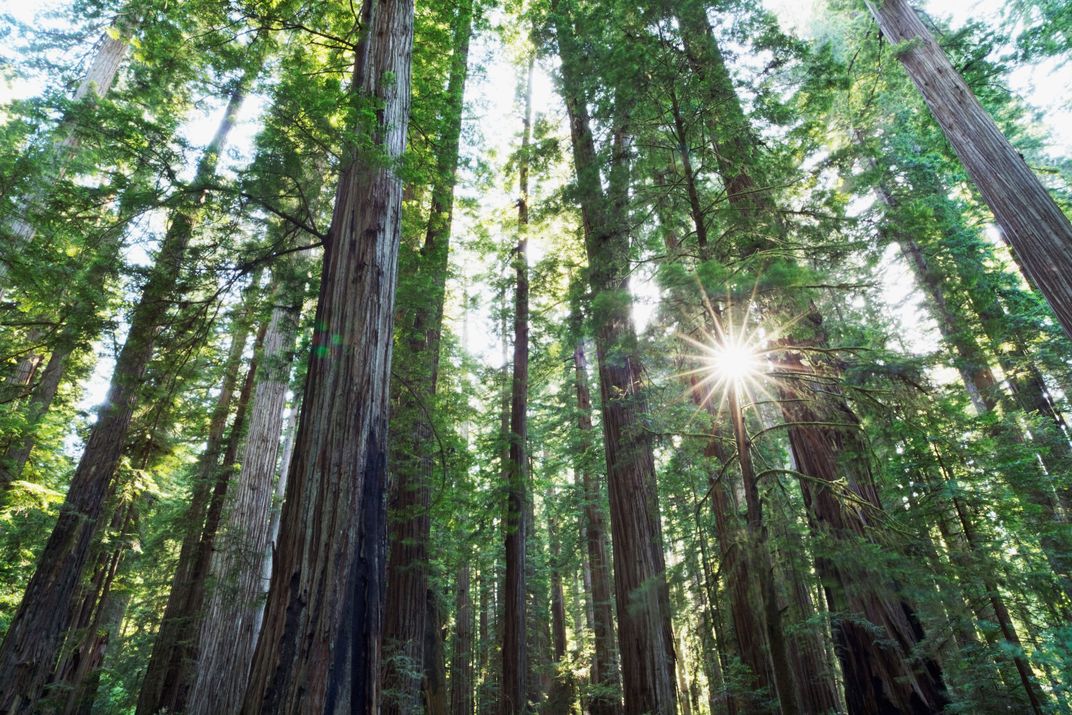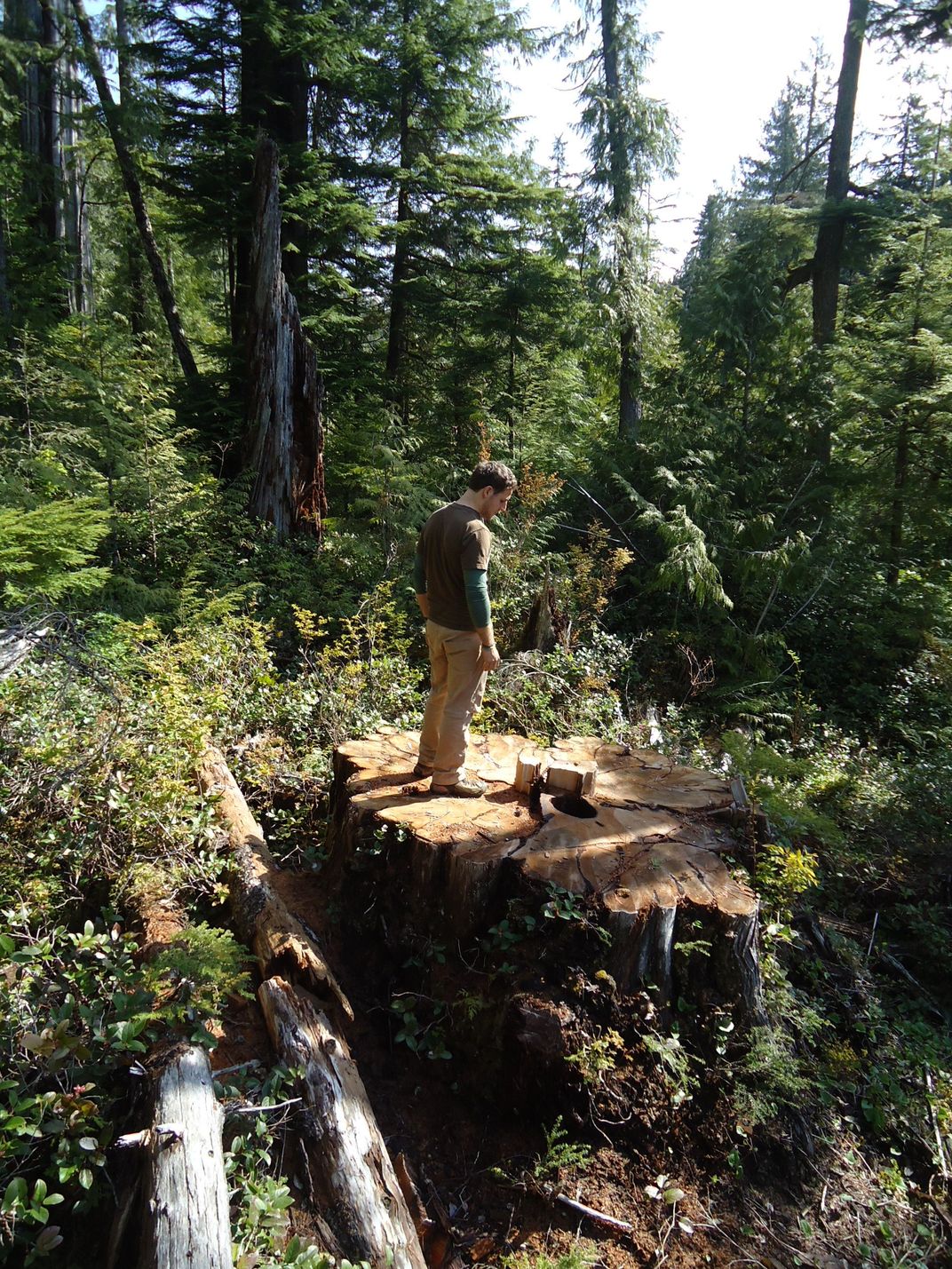How Thousand-Year-Old Trees Became the New Ivory
Ancient trees are disappearing from protected national forests around the world. A look inside $100 billion market for stolen wood
/https://tf-cmsv2-smithsonianmag-media.s3.amazonaws.com/filer/bd/1c/bd1c5bc9-3f5a-43da-8409-e10f530b8de5/carmanah_stumpfromgmtrip.jpg)
I. The Case of the Missing Cedar
It was a local hiker who noticed, during a backwoods stroll in May 2012, the remains of the body. The victim in question: an 800-year-old cedar tree. Fifty meters tall and with a trunk three meters in circumference, the cedar was one of the crown jewels in Canada’s Carmanah Walbran Provincial Park. Now all that remained was a minivan-sized section of its trunk, surrounded by shards of wood and dust, with broken heavy equipment chains lying nearby.
This park is firmly rooted, filled with centuries old Sitka spruce and cedar that impose a towering permanence. These trees are also an integral part of the forest ecosystem: moss and lichen grow on them, mushrooms sprout from the damp bark at their base. Their branches are home to endangered birds like the tiny grey and white marbled murrelet, which scientists presumed regionally extinct until they found a lone bird in the Carmanah.
But lately, these living ecosystems have been disappearing across the province. In the past decade, forest investigators have found themselves fielding cases in which more than 100 trees were stolen at once.
The Carmanah hiker, Colin Hepburn, happened to be a member of the activist group Wilderness Committee. He called Torrance Coste, the protection group’s regional campaigner, who alerted British Columbia Parks and the Royal Canadian Mounted Police (RCMP). A week later, Coste travelled from Victoria to the Carmanah. Coming upon the old growth’s stump was “overwhelming,” he says. He demonstrated its immense size by lying down on it, sitting on it and standing on it in news photos.
The province took the case seriously. The theft was jointly investigated by BC Parks, the RCMP and the province’s Conservation Officer Service, but with no promising leads, the RCMP dropped the case within a few months. BC Parks keeps the file open; Don Closson, the area’s supervisor, says they are waiting to breathe new life into it. But if history is any indication, that isn’t likely to happen: When it comes to the underground world of black market timber, the case of this 800-year-old cedar is just the tip of the iceberg.
Global timber theft has grown into a “rapidly escalating environmental crime wave” according to a 2012 report by the United Nations Environmental Program (UNEP) and Interpol, titled Green Carbon, Black Trade. The report estimates that somewhere between 15 to 30 per cent of the global timber trade is conducted through the black market and linked to organized crime outfits that wouldn’t balk at trading weapons or humans. Now with armed “timber cartels” as part of their operation, these groups have identified profit in the immense value of ancient nature.
Every summer, Interpol and the UNEP hold a conference in Nairobi where they convene over issues in international poaching and black market trade. In the past couple of years, the conference has been focused on elephant poaching and timber theft. Wood, says the UNEP, is the new ivory: a natural resource valued for its scarcity and beauty, which takes decades to grow but just moments to destroy.
“Our parks are comparable to cathedrals or castles in Europe,” says Coste. “But they are not protected. There is no security.”
Globally, poached trees are estimated to be worth somewhere between $30 and $100 billion. The U.S. claims about $1 billion of that in its borders. But it's impossible to truly measure what all that stolen wood is worth.
That’s because the worth of timber is generally only considered in market value—how much you can sell it for in the form of boards or shake blocks—says Matthew Diggs, an attorney in Seattle who has dealt with many timber theft cases. That number doesn’t take into account the fact that, in parks like Washington state’s Olympic National Forest, there are natural ecosystems that can only exist in an untouched environment.
“Honestly, there is really no way to put a value on that,” says Diggs. “[It robs] our region of one of its most precious resources—trees which will take centuries to return.”

II. The Perfect Crime
Two main factors have made timber so appealing in recent years. First, the pay-off: One massive old growth cedar can fetch close to $20,000. A report released in 2000 from the Canadian Forest Service’s Pacific Forestry Centre noted theft of Canada’s timber as a growing problem, costing B.C. $20 million annually. Red cedar is especially at risk, with thieves often specifically targeting its ‘high grade’ old growth. Even smaller parts of trees can be incredibly valuable: In 2014 there were 18 cases of thieves hacking out chunks of burl from 1000-year-old California redwoods.
Second, stealing trees is low-risk. In a globalized economy, timber is exceptionally easy for thieves to get their hands on, says Cameron Kamiya, Canada’s only full-time forest crime investigator. And the Carmanah is the perfect place to commit a crime: a remote rainforest sanctuary on the Canadian west coast, thick with damp air and spearmint canopies of moss. It is so vast and so sparingly visited that park wardens only patrol the area about four times a year.
Kamiya runs a two-person outpost for the whole of British Columbia. In his first case on the job, he charged two men with the theft of broadleaf maple trees from the small town of Abbotsford, which they had been poaching and selling to guitar manufacturers. “Maple is an ongoing problem,” he says. “It isn’t your standard kind of tall, straight tree. It branches off and forks and they lean and tilt, but if you know what you’re doing and you have someone to buy it, it’s quite lucrative.”
That rare successful case illustrates a common theme in timber theft: When thieves are caught, it’s almost entirely thanks to luck. In this case, a group of mountain bikers were forging a path through the woods when they came across three people with a chainsaw and a tree at their feet. The bikers had a GoPro video camera on them, which they used to record the faces of the thieves. Then, they reported the interaction to the Forestry Department, who called Kamiya. Together, Kamiya and Forestry decided to take a hike to the area where the meeting happened.
As they were walking, they heard a tree fall.
The pair snuck up to the top where they found two people they recognized from the video, and who eventually took them to a spot with two others that was dotted with gear: an axe, some jackets, rope. One of the people was covered in dust and was wearing gumboots, making the group’s excuse—“We’re on a hike!”—seem unlikely. A chainsaw was buried amongst some ferns nearby. “They did a really lousy job of it,” says Kamiya. “I don’t know why they bothered.”
Kamiya and the Forestry Department took their culprits down to the main road, but the location was remote and they didn’t have enough room to transport them all back to the station. The group agreed to provide a statement later and, “of course afterwards they all recanted,” Kamiya recalls. In the end only one was charged with the theft. He was given a conditional discharge, six months’ probation and was ordered to pay a $500 fine.
In this field, even charging one thief is unusual, says Kamiya. “It was coincidence and luck,” he says. “It’s like a needle in a haystack when you’re walking around looking for one tree out of a pile.”

III. Wood Without a Name
On paper, a number of government groups are hard at work to reduce illegal logging. The problem is, none of them are equipped to effectively combat a global trade of this magnitude—let alone an organized crime network.
There are the Forest Stewardship Council (FSC) and its European contemporary, the EU Forest Law Enforcement, Governance and Trade Voluntary Partnership Agreements. But these groups are just what the names suggest: That is, voluntary agreement systems for countries and companies to participate in if they choose. Plus, they’re mostly focused on generating incentives for legal trade.
CITES, a convention that many countries follow, regulates the trade of plants and animals, including about 600 timber species. About 400 of these species—including rosewood, bigleaf mahogany and Asian yews—are actively, commercially exploited. In theory, countries that participate in CITES agree to subject exporters to trade regulations, including requiring that they show a permit for the wood they are trading.
But Chen Hin Keong, head of the Global Forest Trade Programme at the wildlife trade monitoring organization TRAFFIC International, says that permits often aren't requested. “There is a good chance that they won’t ask. No one bothers,” says Keong. “If I’m a retailer selling furniture, I can ask my supplier if it’s legal, but he might buy the materials from 10 different sources and he’ll have to check. He might buy his plywood from one place, his dowels from another, planks from somewhere else.”
The hands that a felled log passes through have been greased by the ease of globalized trade. The sheer volume of wood threaded through the world’s largest ports makes it easy to move a single container full of poached wood, or a container full of wood that was both legally and illegally logged. “If you deal drugs or kill an elephant, you are constantly at risk,” says Christian Nellemann, head of rapid response assessments at UNEP. “If you deal with timber, nobody really cares.”
Most timber travels first to busy ports in Malaysia and China, where it is manufactured into finished product before heading to North America and Europe. The pace at these ports is harried. “If you deal with natural resources you generally deal with large volumes of relatively low-value laundered goods. It breaks with the traditional mindset of smuggling,” Nellemann explains. “It would be like trying to check all the fruit and toothpaste in supermarkets.”
Keong likens a piece of furniture to a cell phone—minerals are extracted from one place, everything cobbled together piecemeal in another. Often, when an inspecting officer opens a container of cargo, he or she is sorting through legally sourced items to find the illegal material buried in the middle or hidden underneath. But even if they suspect the wood within may be illegally traded, how are they to know the species of a tree by looking at a piece of plywood?
Right now, the answer is that there’s no way to know for sure. That’s why, in a case like the Carmanah cedar, investigations rarely make it further than the discovery of a stump. After all, a tree’s vanished body is both the victim and the evidence. Even if someone is pulled over with suspicious wood in the back of a truck, the challenge then becomes linking that wood with the tree it once was.
To create a body of proof from the shards left behind, they must be matched to the exact stump it came from. “You have to use other ways,” says John Scanlon, the secretary general of CITES. “You have to look more closely at the texture of the timber. Or sometimes you need forensics.”

IV. Fingerprinting the Forest
As global tree researchers get more savvy, they’re figuring out how to fingerprint wood products back to the ancient trees they came from.
Eleanor White, a retired molecular biologist with the Canadian Forest Services, was the first to develop a way to “fingerprint” trees. In the late 1990s, she developed a method that has since played a key role in advancing a database of red and yellow cedar DNA in British Columbia. White’s method uses a mixture of solvents to isolate short, repeated DNA segments “microsatellites” from samples of wood. Like fingerprints, each tree has a unique pattern of these microsatellites.
Tree fingerprints are just one promising innovation in a relatively new field: forest forensics. New scientific developments are being used to raise the stakes of this kind of lucrative, difficult-to-trace theft. The goal is to dissuade both individual poachers—those who take trees for firewood, or harvest a Christmas tree from preserved land—and large-scale timber thieves alike.
In Oregon, U.S. Fish and Wildlife has developed its own forensics lab to investigate cases of poaching and timber theft. Ken Goddard, the lab’s director, has been working in park crime since 1979. He wrote a manual for environmental crime scene investigation and is also a bestselling serial novelist, having written books like Double Blind, which follows a U.S. Fish & Wildlife special agent into the wilderness.
Today he runs the only lab in the world dedicated to crimes against wildlife—“though we sure don’t want to be,” he says. They tackle some of the most bizarre crimes in America: illegally imported caviar, poached bear gall bladder, plants coated in banned pesticides, and of course, tree poaching.
“When we first started looking at it”—tree theft—“we were stunned,” says Goddard. “We were starting to hear stories from agents in other countries, about entire forests being clear-cut and ships filled with raw trees in containerized cargo. At that point we couldn’t make an identification if it was milled into planks, so we had to come up with something.” Right now they spend a lot of time handling the illegal import of agarwood, which most often makes its way to the lab in the form of wood chips or incense sticks. Known for its dark, aromatic resin that provides the musky, earthy smell common in manufactured scents, a kilo of agarwood can sell for up to $100,000.
The lab guides investigators who intercept these shipments on how to get samples. It isn’t exactly glamorous. The work includes digging through shipping containers filled with raw material and extracting single logs or planks to take back to the lab. “It’s pretty horrendous work, the mechanics and science of it,” says Goddard. “You’re supposed to take a random sampling for results, but imagine a container full of 2x4s and you’re supposed to take the 412th 2x4 in the bunch. It’s a tremendous amount of physical work, to get that sample.”
Very little of the work that the lab’s criminologists, Ed Espinoza and Gabriela Chavarria, do is actually based in the forest. Rather, they most often examine evidence that has already been manipulated; that is, the tree has already been turned into a product. The team will receive boxes of wood chips or shipments of milled, kiln-dried planks from Fish & Wildlife agents or border inspectors, and get to work hunting around for specific ions to determine the species of wood.
They use chemistry to nab tree poachers after the act, because by the time the samples get to them, the wood is almost unrecognizable. On rare occasions, they have been asked to study full logs or planks that have been misleadingly labeled or declared. “With all the shows today, they mix up CSI with forensics and it really isn’t,” says Espinoza.
Espinoza has done groundbreaking work when it comes to developing a method to identify tree genuses: “Up until a few months ago, as far as anyone in the world could go was family,” says Goddard. Espinoza’s work has since been applied to a species of trees called aguilaria, in which agarwood falls. “It’s a mind-boggling discovery,” says Goddard.
Espinoza uses mass spectrometry to identify chemical compounds, essentially by turning an unknown liquid (in this case, oils from bark) into a gas and then injecting it into the dart instrument. The chemical compounds then show up on a screen a few seconds later.

In addition to forensics, there have been some attempts by non-governmental organizations to push for a customer-driven solution. The World Wildlife Foundation is working with companies like Kimberly Clarke, Hewlett-Packard and McDonald’s to help identify places in their supply chain where they may be inadvertently part of the world’s illegal timber trade. McDonald’s, for instance, is focusing entirely on the origins of its paper packaging.
“We can offer real time information to these companies, about sourcing from a certain area,” says Amy Smith, a manager for wood products at the WWF. “We want to keep traceability visible.” But they are also not a regulating body. They essentially provide a service and country profiles, for interested clients.
Yet if there is no political will, Keong fears consumer activism. “People are poor,” he says. “If consumers are put off buying timber then you might affect a lot of livelihoods in other countries. It’s not a simple solution.” Nellemann believes in the power of halting criminal networks is through pressing tax fraud charges. “This is about security, but it’s also about governments losing vast amounts of revenues that leave the country with illegal logging,” he says.
Scanlon agrees: “We need to up the ante here.”
...
When the poet Seamus Heaney was perched at his mother’s deathbed, he wrote in “Clearances”: “The space we stood around had been emptied/ Into us to keep, it penetrated/ Clearances that suddenly stood open/ High cries were felled and a pure change happened.” “I was thinking of when a tree is cut,” he said, in a later interview. “For a moment it’s as if the air is shaken and there is new space in the world. An emptiness.”
Trees are not immortal. They live and die, with the average cedar tree in Canada reaching 800 years or so before cracking, disintegrating and falling down of their own accord. Today, in a ring surrounding the base of the cedar stump in the Carmanah, saplings have begun to sprout. If the earth is lucky, a missing tree will leave a clearing in the canopy, a window into sky and sun, a funnel with enough room for a new tree to grow in its place.
The cedar in the Carmanah was near the end of its life. But tree theft investigators want to ensure that none of these ancient giants meetings a similar fate before its time. Their goal is to make the risks for poaching these trees before their time too high—to treat the theft of plant life like you might the trade of drugs or arms. It’s also to make the act of corruption within government and private business so difficult to pull off that customs agents can do their jobs. The goal can seem impossible.
“I’ve been working on this for awhile now and I still do not…” Keong sighs. “Sometimes I think we are not there yet. We are only in early days. The political will that we are all in this one world … we are not there yet.”
This story was written with the support of the Banff Centre's Mountain and Wilderness Writing Workshop.